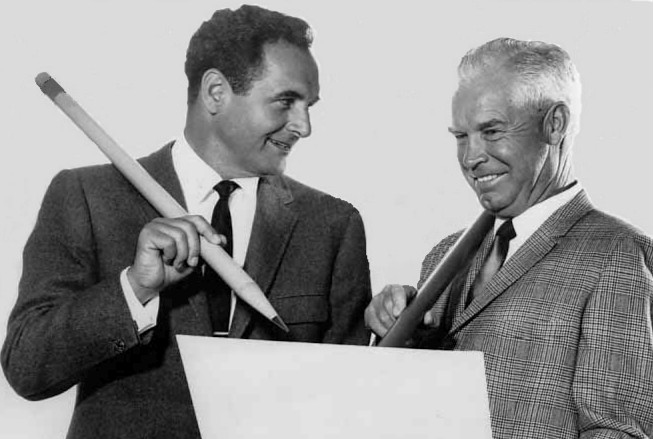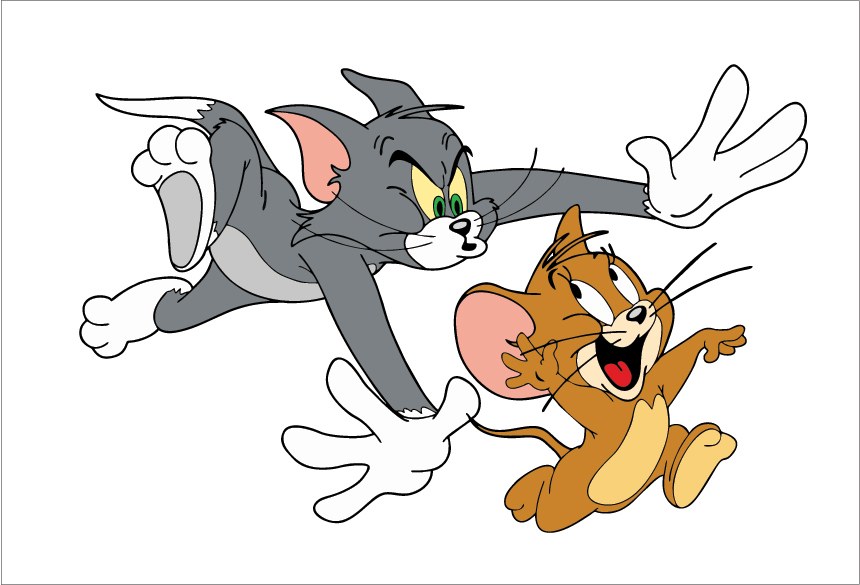Still Fighting Like Cats and . . . Mice: Tom & Jerry Turn 80
Their struggle is an eternal one. Though they sometimes put aside their differences for a common goal, the image lodged in popular consciousness is that of the hunter stalking his prey and the resourceful target outwitting his tormentor. Their battle has lasted eight decades, crossing 161 theatrical shorts, numerous television incarnations, direct-to-video films, video games, and even a Japanese musical adaptation. They are, of course, Tom and Jerry, and here are five things you should know for their 80th anniversary.
1. They’re a Hanna-Barbera Creation

William Hanna and Joseph Barbera worked in Rudolph Ising’s animation unit at MGM. Tom and Jerry wound up being the launch pad for decades of successful collaboration and creation. They founded their own television animation studio in the 1950s, which led to The Flintstones, The Jetsons, The Smurfs, and Scooby-Doo among many, many more.
2. Tom Wasn’t Always Tom, and Jerry Almost Wasn’t Jerry
In the original first short, Puss Gets the Boot, Tom was named Jasper. Jerry doesn’t even have a name in the cartoon, though the name Jinx was discussed during creation. After the first short started to get a positive reaction, an internal contest at MGM settled the name debate, with animator John Carr supplying the final choices. Regardless of the initial indecision about what the boys were called, they still got the attention of the Academy, earning an Oscar nomination for Best Short Subject: Cartoons. Over the course of their theatrical run, they’d be nominated 13 times, and win seven Oscars.
3. They’ve Provoked Quite a Bit of Controversy
Tom and Jerry, like the Road Runner/Coyote shorts and other cartoons, have drawn negative attention over the level of violence (however comically intended) in the shorts. Whereas the characters generally move from one seemingly catastrophic injury to the next without being too worse for wear, watchdog groups have complained about the series’ frequent use of guns and explosives. Smoking scenes have been targeted by advocates as well.
However, perhaps no element of the cartoons has been criticized as much as the character Mammy Two-Shoes. A racial stereotype usually depicted from the knees down, she’s frequently portrayed as Tom’s owner. Over the years, the character has either had her voice redubbed or has been removed from cartoons all together, with a white lady or white teenager animated into the shorts in her place. There are recent DVD releases that contain the original cartoons, but Warner Brothers has added a video introduction featuring Whoopi Goldberg; she addresses that while the stereotypes are wrong, the character is preserved in the release for historical accuracy.
4. New Episodes Stopped Running . . . Wait, They’re Still Running?

Tom and Jerry made the transition from theatres to TV in 1965 with edited versions of the shorts. Since that time, a number of series featuring the pair have run, some with episodes that were new to TV, and some as repurposed anthologies of the shorts. The latest iteration, The Tom and Jerry Show, launched in 2014; its fourth season launched on Boomerang on December 31, 2019.
The pair continue to appear in direct-to-video movies, but the biggest news is that Tom and Jerry will return to movie theaters later this year. A live-action/animation hybrid, the film will star humans Chloë Grace Moretz, Michael Peña, and Colin Jost alongside the animated cat and mouse. The movie is slated for a December 23, 2020 release.
5. Would You Believe There’s a Post Connection?
The 1950 short Saturday Evening Puss is a direct reference to The Saturday Evening Post; the 1957 theatrical re-release even had a title card of Tom sporting the kind of tux, hat, gloves, and cane combo you might have seen in a Leyendecker painting. The installment is significant in the canon because it’s the only cartoon that shows Mammy’s face, although this has been edited out (along with Mammy altogether) in updated versions. The plot has Mammy (or her replacement character) going out for the night while Tom sneaks his buddies in for some raucous jazz, much to Jerry’s dismay; while Jerry engineers Tom’s defeat and the expulsion of all the cats, he’s left defeated by the fact that Mammy, her night out ruined, just plays the same music.
Featured image: Photo 12 / Alamy Stock Photo